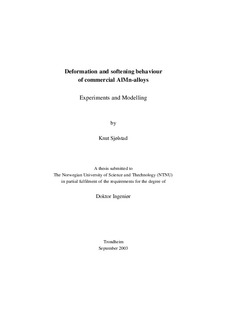| dc.description.abstract | A comprehensive study of the softening behaviour of two different non-heat treatable AlMn-alloys has been carried out. These alloys were a laboratory processed and an industrially processed AA3103-alloy. The primary objective of the laboratory processed alloy has been directed towards the relationship between the amount of manganese in supersaturated solid solution and the material behaviour during deformation and annealing. The focus for the industrially processed alloy was a detailed material characterisation during hot and cold rolling as well as to follow the softening behaviour of the alloy.
The cold rolled microstructures were characterised with respect to subgrain size, misorientation across the subgrain boundaries, particle break-up and global texture. As far as it concerns the cold deformed microstructure it was found that the different homogenisation treatments, resulting in different amount of Mn in supersaturation, had little effect on the deformed microstructure.
Detailed experimental work on the softening behaviour after cold deformation and the interaction between recrystallisation and precipitation, i.e. concurrent precipitation, has been carried out. Hardness and yield stress measurements, which defines the strength of the material, revealed that the softening behaviour was significantly slowed down in case of concurrent precipitation. It was further found that the precipitation reaction in this case occurred on the subgrain boundaries. Thus the precipitates considerably retarded the recrystallisation reaction as compared to the case when no precipitation occurred.
TTT-diagrams have been constructed on the basis of hardness and conductivity measurements. From these diagrams a characteristic temperature, Tc , for the different material conditions are identified. It was found that as the annealing was carried above this temperature the microstructure consisted of a fine grained equiaxed microstructure. Below Tc the grains become elongated in the rolling direction and the average grain size became much coarser.
With respect to recrystallisation texture, a very strong P-texture and in addition some ND-rotated cube texture was found in case of concurrent precipitation. This viistrong P-texture was investigated in detail, and it can be concluded that particle stimulated nucleation of recrystallisation (PSN) plays a significant role in the nucleation of these components. It was found that these texture components had a growth advantage in the early stage of annealing and that they are most probably a result of microgrowth selection, which often are related to a nucleation effect. When precipitation did not interact with recovery and recrystallisation the recrystallisation texture was either random or consisted of a weak cube texture.
The softening behaviour of the different materials has been modelled by a physically based softening model, which involves both the recovery and recrystallisation reactions. Both for the AlMn-alloys and for an additional commercially pure Al-alloy, relatively good model predictions were obtained for the softening behaviour when recrystallisation occurred prior to precipitation. However, when the softening reactions were retarded by heavy precipitation of dispersoids the model, in its original form, was not capable to predict the softening behaviour. In this case an additional retarding drag, which reduces the total number of viable recrystallisation nuclei, was added. With the addition of this drag relatively good model predictions were also obtained in case of concurrent precipitation. However, the model was not capable to predict the softening behaviour of the industrially processed AlMn-alloy particularly well. | nb_NO |
